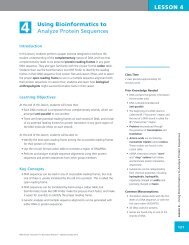WET LAB DNA Barcoding: From Samples to Sequences - Northwest ...
WET LAB DNA Barcoding: From Samples to Sequences - Northwest ...
WET LAB DNA Barcoding: From Samples to Sequences - Northwest ...
Create successful ePaper yourself
Turn your PDF publications into a flip-book with our unique Google optimized e-Paper software.
<strong>WET</strong> <strong>LAB</strong><br />
Glossary<br />
Agarose gel electrophoresis: Electrophoresis refers <strong>to</strong> the process of using an electric field <strong>to</strong> move molecules through<br />
a gel matrix. In the case of <strong>DNA</strong>, agarose is used <strong>to</strong> form the gel matrix, and the electrical current separates <strong>DNA</strong><br />
fragments based on size, with smaller (or lower molecular weight) fragments moving <strong>to</strong> the positive electrode more<br />
quickly than larger fragments.<br />
Amplify: In PCR, <strong>to</strong> amplify is <strong>to</strong> increase in copy number.<br />
Buffer: A substance used <strong>to</strong> stabilize or maintain the pH of a solution.<br />
Cell membrane: Phospholipid bilayer surrounding the cell.<br />
Centrifugal force: The apparent force that seems <strong>to</strong> pull an object outward when the object is spun around in a<br />
circle. This is the force that creates a pellet in the bot<strong>to</strong>m of a microfuge tube during centrifugation or forces material<br />
through a spin column.<br />
Chroma<strong>to</strong>gram: A chroma<strong>to</strong>gram is a type of data file produced by a <strong>DNA</strong> sequencing instrument.<br />
COI gene: Cy<strong>to</strong>chrome c oxidase subunit 1 gene.<br />
Deoxyribonucleotide triphosphates (dNTPs): These are the bases that are used for making <strong>DNA</strong>. They are abbreviated<br />
as dATP (deoxyadenosine triphosphate), dCTP (deoxycy<strong>to</strong>sine triphosphate), dGTP (deoxyguanine triphosphate), and dTTP<br />
(deoxythymidine triphosphate). A mixture containing all four deoxyribonucleotide triphosphates can also be described as a<br />
“set of dNTPs.” See also Dideoxyribonucleotide triphosphates (ddNTPs) and <strong>DNA</strong> sequencing.<br />
Detergents: Substances (for example, soap) that contain both hydrophobic and hydrophilic regions, used <strong>to</strong> dissolve lipids<br />
(i.e., cell membranes).<br />
Dideoxyribonucleotide triphosphates (ddNTPs): Dideoxyribonucleotide triphosphates (abbreviated ddNTPs) are similar<br />
<strong>to</strong> the normal deoxyribonucleotide triphosphates that are used for making <strong>DNA</strong> with one change: they are missing<br />
the 3’ hydroxyl (-OH) group on the deoxyribose sugar. The 3’ hydroxyl group is necessary for <strong>DNA</strong> synthesis<br />
because <strong>DNA</strong> polymerase builds a chain of <strong>DNA</strong> by catalyzing the formation of a phosphodiester bond between the<br />
first phosphate group on the new dNTP and the 3’ hydroxyl group at the end of the <strong>DNA</strong> strand. If the last dNTP in a<br />
<strong>DNA</strong> strand is missing the 3’ hydroxyl group, <strong>DNA</strong> polymerase will be unable <strong>to</strong> add a new base and <strong>DNA</strong> synthesis will<br />
s<strong>to</strong>p. When ddNTPs are used for au<strong>to</strong>mated <strong>DNA</strong> sequencing, they are also labeled with a fluorescent dye. When the<br />
names of these bases are abbreviated, an extra “d” is added <strong>to</strong> indicate that they are missing the 3’ hydroxyl group. The<br />
abbreviations for these bases are: ddATP, ddCTP, ddGTP, and ddTTP. The normal bases are dATP, dCTP, dGTP, and dTTP.<br />
<strong>DNA</strong> polymerase: The enzyme that assembles new <strong>DNA</strong> molecules, in the cell or in vitro in the labora<strong>to</strong>ry, using a <strong>DNA</strong><br />
template and deoxyribonucleotide triphosphates (dNTPs).<br />
<strong>DNA</strong> purification: Extracting the <strong>DNA</strong> from a cell, and purifying it away from the remaining cellular components.<br />
<strong>DNA</strong> sequencing: The process of determining the identity and order of bases in a molecule of <strong>DNA</strong>. A common method<br />
for sequencing <strong>DNA</strong> involves: purifying <strong>DNA</strong> from a sample, making a copy of that <strong>DNA</strong> in vitro (PCR), separating the<br />
new <strong>DNA</strong> molecules by their size, and identifying the base at the end of each <strong>DNA</strong> molecule by measuring the intensity of<br />
the fluorescent signal. This entire process is commonly known as Sanger sequencing after Fred Sanger, the biochemist<br />
who developed the method for using dideoxyribonucleotide triphosphates (ddNTPs) in conjuction with regular<br />
deoxynucleotides (dNTPs) <strong>to</strong> create <strong>DNA</strong> molecules of random sizes. Au<strong>to</strong>mated <strong>DNA</strong> sequencing instruments use capillary<br />
electrophoresis <strong>to</strong> separate the differently sized molecules of <strong>DNA</strong>. Capillary electrophoresis separates <strong>DNA</strong> molecules in a<br />
small capillary tube instead of in an agarose gel. Au<strong>to</strong>mated <strong>DNA</strong> sequencing instruments also contain a laser that excites<br />
the fluorescent dye attached <strong>to</strong> each <strong>DNA</strong> base, instruments that capture and measure the intensity of fluorescence,<br />
and software for processing the fluorescent signal and creating a chroma<strong>to</strong>gram. A key point <strong>to</strong> note is that the <strong>DNA</strong><br />
Wet Lab – <strong>DNA</strong> <strong>Barcoding</strong>: <strong>From</strong> <strong>Samples</strong> <strong>to</strong> <strong>Sequences</strong><br />
345<br />
©<strong>Northwest</strong> Association for Biomedical Research—Updated Oc<strong>to</strong>ber 2012
















